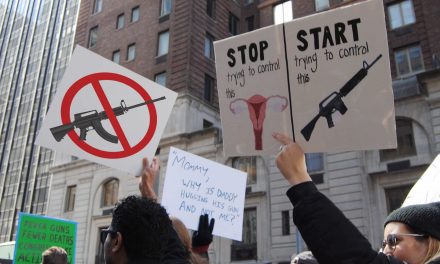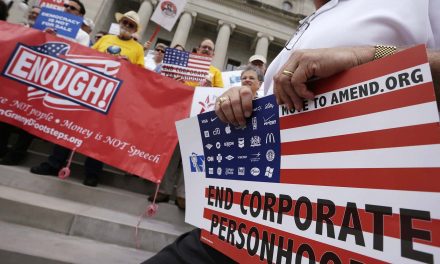
Dear Millennials and Zoomers: back in the 1980s a lot of us worked like hell to try to stop the Reagan revolution. We failed. The next two years may be our last chance to save American democracy, our environment, and what’s left of the American middle-class.
When my Boomer generation was the same average age as the Millennial generation is today, back in 1990, our generation held 21.3% of the nation’s wealth. Louise and I shared in that wealth; although we were still in our 30s, in 1990 we owned a profitable small business (our fourth) and a nice home in suburban Atlanta.
That was, in fact, the “American dream.” It was normal then.
My dad (born 1928), who worked in a tool-and-die shop, was able to buy a house, a new car every two years, and take a two-week vacation every year because the middle class in America before Reagan had a pretty damn good life. He retired in the 1990s with a full pension that let him and my mom travel the world.
Millennials today, in contrast, are about the same number of people as Boomers were in 1990 but hold only 4.6% of the nation’s wealth and, if they’re the same age I was in 1990, they’re most likely struggling to own a home, are deeply in debt, and find it nearly impossible to start a small business.
Yes, you read that right. Boomers in their 30s owned 21.3 of the nation’s wealth; Millennials in their 30s today own 4.6% of the nation’s wealth.
And the story for Zoomers is pretty much the same. As a Bank of America research report noted:
“Like the financial crisis in 2008 to 2009 for millennials, Covid will challenge and impede Gen Z’s career and earning potential.”
Similarly, a Stanford University study that looked at Zoomers shows the consequence of Trump’s disastrous handling of the pandemic:
“[C]ollege graduates who start their working lives during a recession earn less for at least 10 to 15 years than those who graduate during periods of prosperity.”
What happened? In a word, Republicans.
We Boomers remember well the Reagan Revolution of 1981, which laid the foundation for billionaires and giant corporations impoverishing the Millennial and Zoomer generations.
First, GOP fat-cats came for your wages.
Those first two decades of the Reagan Revolution saw the first major attack on workers’ wages since Democratic President Franklin D. Roosevelt passed the National Labor Relations Act, giving union members legal protection from physical and economic violence, way back in 1935.
In 1990, the end of the first decade when millennials were coming into the world, Republicans were still just getting started: 56% of workers who applied for union representation got their union.
That wasn’t as good as during my dad’s generation — 80% of workers got a union when they petitioned for one in the 1940s — but it was still a far cry from what Millennials and Zoomers are facing today as giant trillion-dollar corporations employ the billion-dollar union-busting industry (that didn’t exist in 1980) to keep them from having democracy in the workplace.
In large part this is because “right to work for less” laws — that allow employers to gut their unions — began spreading in a big way in the 1980s and 1990s. The notorious Taft-Hartley law that gave states the legal ability to destroy union rights was passed over President Harry Truman’s veto in 1947, but the National Right To Work Committee wasn’t formed until 1995.
In every single case, anti-worker right-to-work-for-less laws have been passed in states controlled by Republicans at the time of passage; Democrats fought these anti-worker laws from the beginning and continue to do so.
Nonetheless, employers have big bucks and can buy a lot of elections and politicians: what started as a trickle in the 1950s has turned into a flood since Reagan’s presidency. Today right-to-work-for-less states include Arizona, Alabama, Arkansas, Florida, Idaho, Georgia, Indiana, Kansas, Iowa, Kentucky, Michigan, Louisiana, Mississippi, Nebraska, Missouri, Nevada, North Dakota, North Carolina, Oklahoma, South Dakota, South Carolina, Tennessee, Utah, Virginia, Texas, Wisconsin, and Wyoming.
Then they came for your right to an education.
Before Reagan became governor of California, the entire University of California system was free. Reagan did away with that as governor, and then, as president, began the methodical process of eliminating federal and state support for tuition, saying he didn’t want to “sponsor the intellectual curiosity” of “brats” who “protest my policies.”
I went to college — briefly — in the late 1960s and the only person I knew who had college debt was a friend working on his graduate degree at MSU. I paid my tuition working part-time jobs as a dishwasher at Bob’s Big Boy on Trowbridge Road in East Lansing and changing tires and pumping gas at the Esso station across the street.
My mom paid her own way through 4 years of MSU in the 1940s with the money she made as a summer lifeguard up in her home town of Charlevoix, Michigan. My dad, like most men of his generation, was paid to go to college by the GI Bill.
Now, Republicans have not only changed the bankruptcy laws so that you are no longer “cleared“ after seven years like it was when I was coming up, but you can’t even discharge student loans in bankruptcy. This was arguably one of the largest gifts the GOP ever gave the banking industry’s billionaires.
After that, they went after entrepreneurs and local businesses.
I dropped out of college in part because the small business Louise and I had started in 1969 — an electronics repair shop across the street from MSU — had grown to five employees and I was making as much money as my dad.
Back then pretty much every business in East Lansing was locally owned, from the restaurants and hotels to the furniture and clothing stores and appliance shops. The only chain store I remember was the Sears that anchored the local mall; almost all of the rest of the stores in that mall were locally owned.
But then, in 1983, President Reagan ordered the federal government to stop enforcing the anti-trust laws that had been on the books for almost 100 years; the resulting “merger mania” consumed the American economy, with “M&A Artists” (Mergers & Acquisitions) and speculative banksters like the one Michael Douglas played in Wall Street, were ascendant.
Buying up small businesses and crushing them together into giant conglomerates, shedding “excess employees” and employing “economies of scale” were the main way to make money, instead of serving customers and local communities.
Now their absolute market dominance and greed are driving out-of-control inflation, as the normal competitive pressures that keep such behavior in check are dead. And they enthusiastically squash new, upstart businesses — from tech to retail to consumer goods — like bugs.
Thus, your chances of being able to successfully start a business like we did are tiny compared to what they were before the Reagan Revolution, when literally tens of millions of Americans owned small enterprises that they would often hand down from generation to generation.
Then they started squeezing you for cash when you got sick or injured.
Medical debt is another burden that came out of the Reagan Revolution that destroys millions of American families a year: for half-a-million families every year it’s so severe they have to give up their homes and possessions to declare bankruptcy.
America is the only country in the world that experiences medical bankruptcies like this.
When Louise and I started that electronics shop (as teenagers!), we were able to provide all of our employees with full medical insurance because, at that time, both insurance companies and hospitals were required by law (in Michigan and most other states) to be non-profits.
Drug companies weren’t monopolistic monoliths — it was an incredibly competitive industry — and pharmaceutical prices were reasonable, too. The country wouldn’t have tolerated asses like “Pharma Bro” back in the 1960s and 1970s and insulin, which only costs pennies to make, was dirt cheap.
But the neoliberal Reagan Revolution did away with all that, encouraging states to change their laws to bring “free market principles” to healthcare, ending nonprofit requirements. There was, after all, big money to be made, and when somebody is sick and you hold the cure, you have the ultimate power to extract every last penny they have.
As The New York Times noted in an article titled Medical Mystery: Something Happened to U.S. Health Spending After 1980:
“America was in the realm of other countries in per-capita health spending through about 1980. Then it diverged.
“It’s the same story with health spending as a fraction of gross domestic product. Likewise, life expectancy. In 1980, the U.S. was right in the middle of the pack of peer nations in life expectancy at birth. But by the mid-2000s, we were at the bottom of the pack.”
Yep, not only did the parasites get rich, but our nation’s life expectancy actually went down, relative to other wealthy nations.
Now, as the Kaiser Family Foundation (KFF) reported:
“We find that 23 million people (nearly 1 in 10 adults) owe significant medical debt. The SIPP survey suggests people in the United States owe at least $195 billion in medical debt.”
And if the GOP didn’t nail millennials and Zoomers on any of the above, they figured out how to go after your need for a roof over your head.
In the 1990s, as part of Newt Gingrich’s notorious “Contract On America,” Congress “deregulated” the financial industry to the point that it’s become a giant blood-sucking leech attached to your backs.
Thus, Millennials and Zoomers are struggling with housing costs today, and for good reason. Trillion-dollar hedge funds and investment groups are purchasing as many as half (in some towns more) of the available-for-sale housing, so they can turn them into rentals and then, when they’ve cornered the market, jack up the prices.
When my dad bought his home in the 1950s the median price of a single-family house was around 2.2 times the median American family income. Today, the Fed says, the median house sells for $374,900 while the median American income is $35,805 — a ratio of more than ten-to-one between housing costs and annual income.
Louise and I bought our first home in our mid-twenties, as did many of our friends. Banks were locally owned and worked with you; finding fixer-uppers was easy.
No more.
As noted in a Wall Street Journal article titled Meet Your New Landlord: Wall Street, in just one suburb (Spring Hill) of Nashville:
“In all of Spring Hill, four firms … own nearly 700 houses … [which] amounts to about 5% of all the houses in town.”
This is the tiniest tip of the iceberg.
“On the first Tuesday of each month,” notes the Journal article about a similar phenomenon in Atlanta, investors “toted duffels stuffed with millions of dollars in cashier’s checks made out in various denominations so they wouldn’t have to interrupt their buying spree with trips to the bank…”
The same thing is happening in cities and suburbs all across America; the investment goliaths use fine-tuned computer algorithms to sniff out houses they can turn into rental properties, making over-market and unbeatable cash bids often within minutes of a house hitting the market.
After stripping neighborhoods of homes young families can afford to buy, they then begin raising rents to extract as much cash as they can from local working class communities.
In the Nashville suburb of Spring Hill, the vice-mayor, Bruce Hull, told the Journal you used to be able to rent “a three bedroom, two bath house for $1,000 a month.” Today, the Journal notes, “The average rent for 148 single-family homes in Spring Hill owned by the big four [Wall Street investor] landlords was about $1,773 a month…”
As the Bank of International Settlements summarized in a 2014 retrospective study of the years since the Reagan/Gingrich changes in banking and finance:
“We describe a Pareto frontier along which different levels of risk-taking map into different levels of welfare for the two parties, pitting Main Street against Wall Street. … We also show that financial innovation, asymmetric compensation schemes, concentration in the banking system, and bailout expectations enable or encourage greater risk-taking and allocate greater surplus to Wall Street at the expense of Main Street.”
It’s a fancy way of saying that big banks and hedge funds are now worth trillions while you and your community are destitute.
And forget about getting a loan to start a small business in this big-bank environment of today.
When Louise and I started our first business, we did it with a $3000 loan from a small local Michigan bank. Back then bankers were part of the local community and eager to do what they could to help the community grow and prosper.
Nowadays they just want to extract every penny they can from you so their CEO can buy another megayacht. And then Republicans came for your wealth, in a huge way.
Finally, perhaps the most important of the reasons Millennials and Zoomers are so badly screwed these days are the various changes in our tax code that began in the 1980s.
Reagan dropped the top income tax rate on the morbidly rich from 74% down to 27%, and cut corporate tax rates from 50% to functionally nothing. America’s richest millennial, Mark Zuckerberg, owns fully 2 percent or 1/50th of ALL the wealth of ALL millennials in the country.
The average billionaire pays an income tax rate of under 3%, and the majority of our nation’s largest corporations not only pay nothing in annual income taxes but most have so gamed the system that they get money back.
And where does that money come from? It’s taken out of the taxes the government collected from you and me.
This 42-year-long process, with Reagan’s original massive tax cuts amplified by trillions more in tax cuts for the morbidly rich from the Republican George W. Bush and Donald Trump administrations, has produced a $50 trillion transfer of real wealth from the middle class to the top 1%.
You read that right: they have taken $50 trillion dollars out of our pockets over the past 42 years and stashed it in their money bins.
When Reagan was elected there wasn’t a single billionaire in America; now they’re appearing like popcorn, while all around us homelessness spreads like a relentless fungus, destroying the lives of millions of Americans — particularly Millennials and Zoomers.
The bottom line, my dear Millennial and Zoomer friends, is that you’ve been had by the GOP.
And now that Republicans have handed all that money over to the top 1% — and five corrupt Republicans on the Supreme Court ruled in their 2010 Citizens United decision that billionaires and corporations owning politicians isn’t corruption or bribery but “free speech” — its getting harder and harder to do anything about it.
Every time any sort of reform — even modest, reasonable reforms — come before Congress, a united block of Republicans in the Senate haul in another billion dollars in campaign contributions and Mitch McConnell and his friends kill it with the filibuster.
And don’t get me started on climate change, which Republicans, right across-the-board, continue to deny, in deference to the fossil fuel industry and its billionaires that funds their elections. They’ve put money and power above the fate and future of your and your children’s planet.
They even tried to end our 240-year experiment in democratic self governance, and are now actively embracing neofascist autocracy, openly trying to emulate the rightwing strongman governments that have taken over Russia and Hungary.
Like Russia and Hungary, they’ve succeeded in overturning the right to abortion in the states they control and are openly embracing homophobia and misogyny.
And did I mention over 400 million guns drenching our country in blood, and Republican Senator John Cornyn recently saying that Republicans are unified across-the-board to prevent any further action to stop gun violence in America?
I’m so embarrassed to have to say this, but my generation let this happen. Back in the 1980s, huge numbers of Boomers voted for the Reagan Revolution that kicked off this whole political and economic death spiral. The guilt is largely ours.
And now, these Republicans are trying to marinate your children in their white supremacy and racism by forcing teachers to push a false narrative about American history — all while they try to rig our elections by purging millions of minority, Millennial, and Zoomer voters from the rolls with the 2018 blessing of a corrupt Supreme Court.
The good news, however, is that, increasingly, older and younger generations are working together to throw Republicans out of office and elect progressive Democrats who understand these issues and know how to do something about it.
From 80-year-old Senator Bernie Sanders to 25-year-old progressive Democrat Maxwell Frost who just won a House seat, progressives are growing in political power at the same time America is waking up from the fog of bullshit Republicans have been crop-dusting over us since 1981.
All is not lost; change is in the air. And Millennials and Zoomers, as we saw in last week’s election, are leading the way.
Fizkes
© Thom Hartmann, used with permission. Originally published on The Hartmann Report as Dear Millennials & Zoomers: I’m Sorry We Didn’t Stop Them
Subscribe to The Hartmann Report directly and read the latest views about U.S politics and other fascinating subjects seven days a week.














